Yoga in Rishikesh
What is Yoga ?
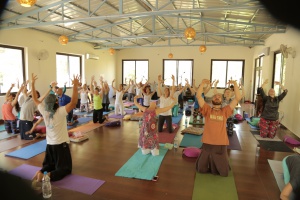
In modern times, yoga is primarily known for its physical postures, or asanas, which are designed to increase flexibility, strength, and balance. However, yoga also includes breathing techniques, meditation, and ethical guidelines for living a healthy and meaningful life.
The physical postures of yoga are designed to prepare the body for meditation by releasing tension and promoting relaxation. In addition, the breath is considered to be a vital aspect of yoga practice, and breathing techniques are used to calm the mind and increase focus.
Overall, yoga is a holistic practice that is designed to promote physical health, mental clarity, and spiritual growth. It is accessible to people of all ages and fitness levels, and can be adapted to suit individual needs and abilities.
Why Rishikesh Is Famous For Yoga
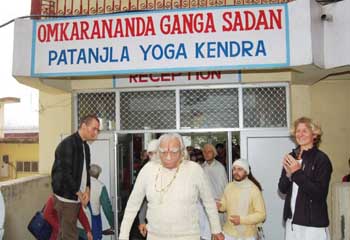
Rishikesh is widely considered to be the “Yoga Capital of the World” because it has a long history of yoga practice and is home to many renowned yoga masters and teachers.
Rishikesh is located in the foothills of the Himalayas, and it is considered to be a spiritual hub in India, where many saints and sages have come to meditate and practice yoga over the centuries. In the early 20th century, Rishikesh gained global recognition as a center for yoga and spiritual learning when the renowned yoga master Swami Sivananda established an ashram there. Many other yoga masters and gurus have followed, making Rishikesh a center for yoga and spiritual education.
Today, Rishikesh is home to numerous yoga centers, ashrams, and schools that offer a range of yoga programs and courses for people of all levels and abilities. The town is known for its serene and peaceful atmosphere, natural beauty, and spiritual energy, all of which make it an ideal place for yoga and meditation practice.
The Ganges river, which flows through Rishikesh, is also considered to be a sacred river in Hinduism, adding to the spiritual energy of the town. For these reasons, Rishikesh has become a popular destination for people from all over the world who are interested in practicing yoga, learning about Indian culture and spirituality, and experiencing the transformative power of yoga.
Top Yoga Schools In Rishikesh
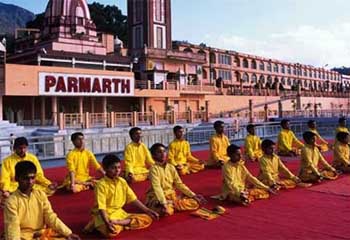
Parmarth Niketan: One of the most renowned yoga centers in Rishikesh, Parmarth Niketan offers a range of yoga and meditation courses, including daily yoga classes, special workshops, and yoga teacher training programs.
The Yoga House: The Yoga House is a popular yoga center in Rishikesh that offers a variety of yoga and meditation classes, as well as Ayurvedic treatments and therapies.
Rishikul Yogshala: Rishikul Yogshala is a well-known yoga school in Rishikesh that offers yoga teacher training courses, as well as drop-in yoga classes and workshops.
Sivananda Ashram: The Sivananda Ashram is a traditional ashram that offers yoga and meditation courses, as well as a range of spiritual and cultural programs.
Anand Prakash Yoga Ashram: Anand Prakash Yoga Ashram offers yoga teacher training programs and drop-in yoga classes, as well as courses in Ayurveda and other healing arts.
Tattvaa Yogashala: Tattvaa Yogashala is a popular yoga school in Rishikesh that offers yoga teacher training programs, as well as daily yoga classes and workshops.
These are just a few of the many yoga centers and ashrams in Rishikesh. Each center has its own unique approach to yoga and meditation, so it’s important to research and choose a center that aligns with your interests and goals.
Types of Yoga's
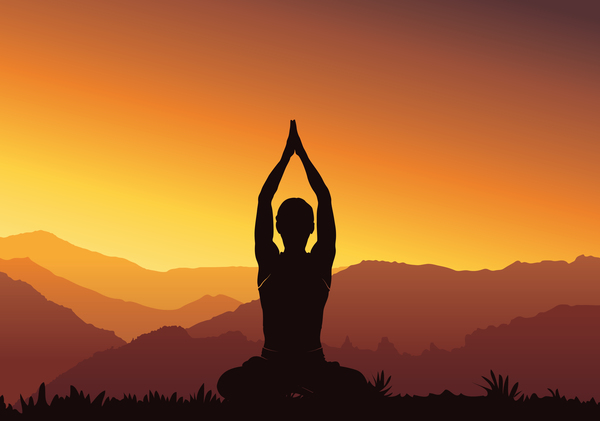
There are many different types of yoga, each with its own unique approach to physical postures, breathing techniques, meditation, and philosophy. Here are some of the most popular types of yoga:
Hatha Yoga: This is a classic form of yoga that focuses on physical postures and breathing techniques to prepare the body for meditation. It is a gentle, slow-paced practice that is suitable for all levels.
Vinyasa Yoga: This is a dynamic, flowing form of yoga that synchronizes movement with breath. It can be a more challenging practice, as it involves a series of continuous, fluid movements.
Ashtanga Yoga: This is a physically demanding form of yoga that involves a set series of postures performed in a specific order. It is a vigorous practice that builds strength and flexibility.
Iyengar Yoga: This is a precise form of yoga that emphasizes alignment and uses props, such as blocks and straps, to help students achieve correct postures. It is a great practice for beginners and those with injuries.
Kundalini Yoga: This is a spiritual form of yoga that incorporates physical postures, breathing techniques, and meditation to awaken the energy at the base of the spine and promote spiritual growth.
Yin Yoga: This is a slow, meditative form of yoga that involves holding postures for several minutes to release tension and promote relaxation.
Restorative Yoga: This is a deeply relaxing form of yoga that involves using props to support the body in passive postures for extended periods of time. It is a great practice for reducing stress and promoting deep relaxation.
These are just a few of the many types of yoga available. Each practice has its own unique benefits and can be adapted to suit individual needs and abilities.
TYPES OF PRANAYAMA
- NADI SHODHANA PRANAYAMA: It is known as Nadi Shodhana Pranayama in Sanskrit, this translates as “subtle enrgy clearing breathing method”. This type of breath work can be done as part of a yoga or meditation practice. Alternate nostril breathing can also be done as its own practice to help you quiet and still your mind. The benefits of this pranayama are, it clears and release toxins. Reduces stress and anxiousness, calms the nervous system, balances hormones, clear and balance respiratory canals.
- BHASTRIKA PRANAYAMA: This is a process of rapid inhalation and exhalation which gives a lift to the body and suitably called the yogic breath of fire. If your body feels like it needs energy try bhastrika pranayama. It is good in energizing the body and mind, it also helps remove toxins and impurities, it helps in the sinus, bronchitis and other respiratory issues.
- KAPALBHATI PRANAYAMA: Kapalbhati is the rapid breathing technique of Pranayama, which is considered as a cure for various affections. The possible use of this technique to combat metabolic syndrome(MS) and polycystic ovarian syndrome(PCOS) has been discussed in this article. It is best for strengthening the functions of the liver and kidneys. It also helps, causing hair growth, and detoxifying your skin. Also, the Kapalbhati breathing benefits also include soothing sinus and asthma.
- BHRAMARI PRANAYAMA: Bharmari Pranayama, also known as humming bee breath, is a comforting breathing practice that soothes the nervous system and helps to connect us with our inner nature. Advantages of Bhramari Pranayama are calm and quite the mind, release cerebral tension, soothes the nerves, relieves stress and anxiety, dissipates anger, lower blood pressure, boost health of the throat, strengthens and improves the throat.



- ANULOM VILOM: It is a especial type of pranayama, or controlled breathing in yoga. It involves holding one nostril closed while inhaling, then holding the other nostril closed while exhaling. The process is also reversed and repeated. This has many physical and psychological benefits, including: improved breathing, improved cardiovascular function, stress reduction.
- SHEETALI PRANAYAMA: Sheetali pranayama also known as cooling breath, is a breathing practice that actually effectively cools the body, the mind, and the emotions. Sheetali comes from the Sanskrit, sheet which means “cold” or ‘frigid”. Benefits of sheetali pranayama are: balances excess pitta, cools the body and clears excess heat, promotes optimal digestion, soothes inflammatory skin conditions, calms the mind, reduces fever, reduces blood pressure.
- SURYA BHEDNA PRANAYAMA: Surya Bhedna is a warming pranayama or breath work, concentrated on one nostril: the right surya, or sun, refers to the right nostril of the nose which is connected to the Pingala nadi of the body. It increases the flow of gall and reduces Phlegm and gas in the body. It also improves blood circulation and purification. Surya bhedna pranayama improves digestion and delays aging.
- CHANDRA BHEDNA PRANAYAMA: This is a yoga breathing technique performed in a cross-legged meditation posture. It involves blocking the right nostril, forcefully inhaling through the left nostril, retaining the breathe as long as comfortable blocking the left nostril, and exhaling through the right nostril. It is beneficial in regulating the flow of bile. Daily practice reduces heart practice reduces heart burns or excessive heat in the body.
TYPES OF ASANAS
- BHUJANGASANA: (COBRA POSE) Bhujanagasana is the Sanskrit name for a popular yoga asana, else also known as cobra pose. It is a slow backbend, most generally performed as part of Sun Salutation. The term bhujangasana is deduced from two Sanskrit roots; bhujanga meaning “snake” and asana meaning “posture”. Bhujangasana is actually very useful to keep your back healthy, This also improves your digestion, liver and kidney functions as well.
- TADASANA: A simple standing asana, which forms the base for all the standing asanas. It is performed at the start and close of the surya namaskar sequence and is a key asana for all yoga practices. Tadasan (from the Sanskrit words “tada” meaning “mountain” and “asana” meaning “pose”) is a introductory yoga pose where the yogi plants their feet on the ground as their body stands firm and straight. It centers your body and mind, which helps produce a calm sense of inner peace. Standing strong and centered in pose, helps to improve posture alignment, and balance.
- SUN SALUTATION: One of the means of recognizing the sun is through the dynamic asana sequence surya namaskar( better known as sun salutation). The important benefits of day-to-day sun salutation: Become centered and grounded, produce focus for your day, gain muscle and flexibility, leave your pride behind, boost the immune system and overall health, de-stress and find inner peace.
- DHANURASANA: Dhanurasana is a back bend that deeply opens the chest and the front of the body. This pose is a complete yoga asana that helps to strengthen the back and abdominal muscles. The health benefits may include enhancing blood rotation, adjusting hunched back and body posture, managing diabetes, digestive ailments and chest ailments etc.
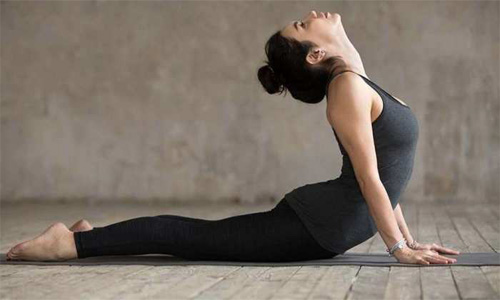


- MAKARASANA: Makarasan or crocodile pose is a reclining asana that relaxes the body, stimulates the sacral chakra, and can even be used for contemplation or pranayama. This crocodile pose is a deeply restrotive pose that helps relax your nervous system and strengthens the muscle in your back.
- DANDASANA: Dandasana or staff pose is a seated asana in ultra-modern yoga as exercise. When performed rightly, Dandasaana strengthens all major core muscles, improves posture, and increases stamina, it also strengthens back muscle, stretches the spine, stretches shoulders and chest, helps to calm brain cells, improve functionality of the digestive organs.
- CHAKRASANA: It is a strong back-bending yoga asana, it is popular in numerous forms of yoga and is part of the primary series of ashtanga yoga. Chakrasana, also benefits a deep stretch for the chest and shoulder muscles, as well as the hip flexors. It also strengthens the hamstrings and spinal extensors.
- NATRAJASANA: It is a standing asana that requires balance and attention. Natrajasana lord of the dance pose or dancer pose in a standing, balancing, back-bending asana in modern yoga as exercise. It is derived from a pose in the classical Indian dance form Bharatnatyam, which is depicted in temple statues in the Natraja Temple Chidambaram. Rehearsing this asana gives strength to your chest, ankles, hips, and legs, this asana increases your metabolism and helps in weight loss, it helps to improve your digestion.
